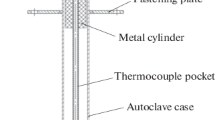Abstract
In the coking of heavy tar at 450–550°C, the influence of added carbon nanotubes on the yield of petroleum coke is studied. The properties of the resulting coke–nanotube composite are determined. Electron-microscopic data show that, in coking a mixture of heavy tar and nanotubes, the petroleum coke is reinforced by carbon nanotubes. Adding carbon nanotubes to heavy tar decreases its sulfur content. The drop in sulfur content of the petroleum coke is associated with the transfer of sulfur to hydrogen sulfide and COS, which are removed with the gas phase. With increase in the content of carbon nanotubes in petroleum coke, the electrical resistance of the coke–nanotube composite declines. Adding 5% of carbon nanotubes to the heavy tar lowers the resistance of the coke produced by a factor of 20.




Similar content being viewed by others
REFERENCES
Gary, J.H., Handwerk, G.E., and Kaiser, M.J., Petroleum Refining: Technology and Economics, Boca Raton, FL: CRC Press, 2007.
Pokhodenko, N.T. and Brondz, B.I., Poluchenie i obrabotka neftyanogo koksa (Production and Processing of Petroleum Coke), Moscow: Khimiya, 1986.
Kondrasheva, N.K., Rudko, V.A., and Nazarenko, M.Yu., Influence of pressure in the coking of heavy oil tar and asphalt on the coke properties and structure, Coke Chem., 2018, vol. 61, no. 12, pp. 483–488.
Lavrova, A.S., Vasilyev, V.V., and Strakhov, V.M., Comparison of the coking products from heavy petroleum tars and heavy catalytic-cracking gas-oil, Coke Chem., 2019, vol. 62, no. 4, pp. 164–168.
Meier, M.W., Cracking behavior of anodes, PhD Thesis, Zurich: Fed. Inst. Technol., 1996.
Akhmetov, M.M., Zaitseva, S.A., and Gimaev, R.N., Proizvodstvo i primenenie prokalennogo igol’chatogo koksa (Production and Application of Calcined Needle Coke), Moscow: Tsentr. Nauchno-Issled. Inst. Inf. Tekh. Ekon. Issled. Neftepererab. Neftekhim. Prom., 1983.
Niu, P.X., Wang, Y.L., and Zhan, L., Electrochemical performance of needle coke and pitch coke used as anode material for Li-ion battery, J. Mater. Sci. Eng., 2011, vol. 29, pp. 204–209.
Hume, S.M., Influence of Raw Material Properties on the Reactivity of Carbon Anodes Used in the Electrolytic Production of Aluminum, Siene: R&D Carbon, 1993, 2nd ed.
Fischer, W.K. and Perruchoud, R.C., Influence of coke calcining parameters on petroleum coke quality, Proc. AIME Annual Meeting “Light Metals,” Warrendale, PA, 1985, pp. 811–826.
Halim, H.P., Im, J.S., and Lee, C.W., Preparation of needle coke from petroleum by-products, Carbon Lett., 2013, vol. 14, p. 152.
Predel, H., Petroleum coke, in Ullmann’s Encyclopedia of Industrial Chemistry, Bohnet, M., Ed., Weinheim: Wiley, 2012.
Cheng, Y., Zhang, Q., Fang, C., et al., Co-carbonization behaviors of petroleum pitch/waste SBS: influence on morphology and structure of resultant cokes, J. Anal. Appl. Pyrol., 2018, vol. 129, pp. 154–164.
Kapustin, V.M. and Gureev, A.A., Tekhnologiya pererabotki nefti. Chast’ 2. Destruktivnye protsessy (Oil Refining Technology, Part 2: Destruction Processes), Moscow: Kolos, 2007, pp. 81–82.
Kretinin, M.V., Mekhanotekhnologicheskie aspekty proizvodstva neftyanogo koksa (Mechanotechnological Aspects of Petroleum Coke Production), Ufa: Inst. Neft. Khim. Pererab., 2009.
D’yachkov, P.N., Uglerodnye nanotrubki: stroenie, svoistva, primenenie (The Structure, Properties, and Applications of Carbon Nanotubes), Moscow: BINOM. Laboratoriya Znanii, 2006.
Chesnokov, V.V., Buyanov, R.A., and Chichkan’, A.S., Catalyst and technology for production of carbon nanotubes, Kinet. Catal., 2010, vol. 51, no. 5, pp. 776–781.
Chesnokov, V.V., Chichkan, A.S., and Paukshtis, E.A., Effect of carbon nanotube admixture on anthracene coking, Petrol. Chem., 2019, vol. 59, no. 2, pp. 186–191.
Funding
Financial support was provided by the Russian Science Fund (project 17-73-30032).
Author information
Authors and Affiliations
Corresponding authors
Additional information
Translated by B. Gilbert
About this article
Cite this article
Chesnokov, V.V., Chichkan, A.S., Moseenkov, S.I. et al. Influence of Carbon Nanotubes on the Properties of Coke Derived from Heavy Tar. Coke Chem. 64, 522–526 (2021). https://doi.org/10.3103/S1068364X21110028
Received:
Revised:
Accepted:
Published:
Issue Date:
DOI: https://doi.org/10.3103/S1068364X21110028




